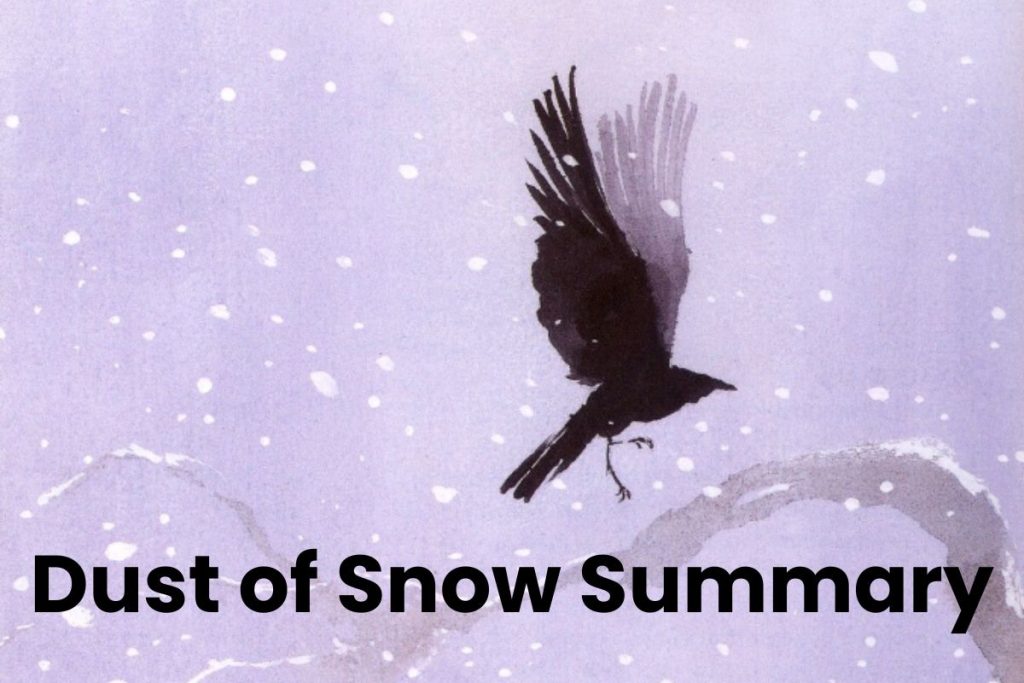Dust of Snow Summary: The poem, “Dust of Snow” by Robert Frost is one of the prime poems in the Class 10 syllabus of the Central Board of Secondary Education. Students who have to appear for the CBSE Board Exams of the tenth class must be thorough with the gist, idea, theme and more aspects of the poem. The questions in terms of poetry can be based on the concepts rather than being highly specific. In the case of Dust of Snow, the poem is highly expressive, short, and meaningful.
The students need to understand the aspects of the poem if they seek to properly be able to answer the questions. Furthermore, the poem very intricately uses symbolism for the purpose of the deliverance of the idea. Hence, students must carefully understand the relative meanings.

In the following article, we have provided the Dust of Snow Summary and all the relatively important details pertaining to the poem. Students must read all the details mentioned subsequently if they aim to score well in the Exams in the section comprising this poem.
Dust of Snow Summary
Robert Frost is a well-acknowledged poet. His poems are not only very distinctive but also highly symbolic and meaningful. The poem, “Dust of Snow” is one of them. The poem is presently part of the Central Board of Secondary Education CBSE’s Class 10 English Board Exam and the students often find it difficult since the poem is concise but highly symbolic. The questions are relative to the symbolism. Hence, the students must focus on being thorough with all the concepts of the poem. The questions will be based on little details and they might even want the students to explain the lines.
Hence, an intricately written summary will help to understand the poem and accordingly write answers. Additionally, students must pay attention to the literary devices employed in the poem as they can also form questions.
Dust of Snow by Robert Frost
The way a crow
Shook down on me
The dust of snow
From a hemlock tree
Has given my heart
A change of mood
And saved some part
Of a day I had rued.
A Letter to God Summary Class 10 English
Summary of “Dust of Snow” by Robert Frost
The poem opens with a setting in the season of winter where the poet is presumably standing under the hemlock tree. The season signifies the cold and dampness in the life of the poet. The indication of the winter season through the dust of snow signifies the changing but the present phase of life where the poet is unecstatic about life. Hemlock tree further adds to the negativity as it signifies poison and death. It can be assumed that the poet was lost in some lethal thought concerned with the dangers of life. It also leads to the conclusion that the poet might have been thinking about taking his own life.
A crow shooks down the dust of snow at the poet as per the events in the poem. The crow is believed to be a very unloved bird and is of black appearance. The poet has employed the use of this particular bird to symbolise the rising negativities in life and their sudden intrusion.
It is in the second verse that the poet feels a sudden sense of positivity despite all the negativity and darkness. Even though the snow is in a very lesser amount, it is still reflective of white and it only takes a little ray of hope to feel better. Here, the poet feels a change in mood at that very moment. As the poet admits that the moment changed some part of him, it can be deduced that the poet might have revived hopes in life. This has made the present phase much better for him in a day which he earlier regretted.
Moral of the Poem Dust of Snow
The poem implies the importance of one instance of positivity. The poet intends to shift the focus of the readers to the little things in life and how they can brighten the day bringing a swift breeze of satisfaction. The poet also strives to suggest that if it is to be observed, the positives can be counted instead of fixating on the negatives.
Literary or Poetic Devices in the Poem
Here are a few literary devices that were included in the poem:
- Rhyming Scheme: abab
- Imagery: Simple Imagery through words in the poem
- Metaphor: The word “dust” is used to indicate snow above the hemlock tree.
- Alliteration: And saved some part
- Assonance: “Shook down on me” in which the sound of “O” is highly prominent.
- Enjambments: There is an omission of punctuation marks throughout the poem.
Aptness of the Title
The poet compares a very little mass of snow to “Dust of Snow” and it is that little presence which changes his mood for him. Hence, the title is extremely appropriate as it is the “Dust of Snow” which acts as the character of prominence and indicates that despite its quantity, it holds extreme importance as it has the potential to be considered as a positive in a setting full of poison, coldness, dampness, darkness, and negativity.







